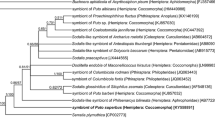Summary
All anoplurans live symbiotically with prokaryotic microorganisms hosted in specialized cells, termed mycetocytes. In nymphs and males mycetocytes are distributed between midgut epithelial cells. In females, besides the midgut, mycetocytes are found in the reproductive organs where they are located at the base of ovarioles in contact with lateral oviducts. The mycetocyte-associated symbionts are transmitted from one generation to the next transovarially. Here, the results of histological and ultrastructural studies on the distribution and transmission of symbiotic microorganisms within the ovaries of the anopluranHaematopinus suis are presented. Interestingly, during advanced oogenesis (i.e., choriogenesis) of this species all symbionts are localized extracellularly and form a tight mass located at the posterior pole of the oocyte just below the hydropyle. In insects studied so far, such localization of transovarially transmitted microorganisms has been reported only in the closely related speciesHaematopinus eurysternus.
Similar content being viewed by others
References
Akhtar S, van Emden HF (1994) Ultrastructure of symbionts and mycetocytes of bird cherry aphid (Rhopalosiphum padi). Tissue Cell 26: 513–522
Al-Khalifa MS (1984) The transovarial transmission of symbionts in the grain weevil,Sitophilus granarius. J Invertebr Pathol 44: 106–108
Baumann P, Moran NA (1997) Non-cultivable microorganisms from symbiotic associations of insects and other hosts. Antonie van Leeuwenhoek J Microbiol Serol 72: 39–48
Biliński SM (1989) Formation and function of accessory nuclei in the oocytes of the bird louse,Eomenacanthus stramineus (Insecta, Mallophaga) I: ultrastructural and histochemical studies. Chromosoma 97: 321–326
— (1998) Ovaries, oogenesis and insect phylogeny: introductory remarks. Folia Histochem Cytobiol 36: 143–145
—, Büning J (1998) Structure of ovaries and oogenesis in the snow flyBoreus hyemalis (Linne) (Mecoptera: Boreidae). Int J Insect Morphol Embryol 27: 333–340
—, Jankowska W (1987) Oogenesis in the bird louseEomenacanthus stramineus (Insecta, Mallophaga) I: general description and structure of egg capsule. Zool Jahrb Abt Anat Ontog Tiere 116: 1–12
Blochmann F (1887) Bakterienähnliche Körperchen in den Geweben und Eiern. Biol Zentralbl 7: 606–608
Brough CN, Dixon AFG (1990) Ultrastructural features of egg development in oviparae of the vetch aphid,Megoura viciae Buckton. Tissue Cell 22: 51–63
Buchner P (1953) Endosymbiose der Tiere mit pflanzlichen Mikroorganismen. Birkhäuser, Basel
Büning J (ed) (1994) The insect ovary: ultrastructure, previtellogenic growth and evolution. Chapman and Hall, London
Costa HS, Westcot DM, Ullman DE, Johnson MW (1993) Ultrastructure of the endosymbionts of the whitefly,Bemisia tabaci andTrialeurodes vaporariorum. Protoplasma 176: 106–115
— — —, Brown JK, Johnson MW (1995) Morphological variation inBemisia endosymbionts. Protoplasma 189: 194–202
—, Toscano NC, Henneberry TJ (1996) Mycetocyte inclusion in the oocytes ofBemisia argentifolii (Homoptera: Aleyrodidae). Ann Entomol Soc Am 89: 694–699
Dadd RH (1985) Nutrition: organisms. In: GA Kerkut, LI Gilbert (eds) Comprehensive insect physiology, biochemistry and pharmacology, vol 4. Pergamon Press, Oxford, pp 313–390
Dasch AG, Weiss E, Chang KP (1984) Endosymbionts of insects. In: NR Krieg (ed) Bergey's manual of systematic bacteriology, vol 1. Williams and Wilkins, Baltimore, pp 881–883
Douglas AE (1989) Mycetocyte symbiosis in insects. Biol Rev 64: 409–434
— (1998) Nutritional interactions in insect-microbial symbioses: aphids and their symbiotic bacteriaBuchnera. Annu Rev Entomol 43: 17–37
Eberle MW, McLean DL (1982) Initiation and orientation of the symbiote migration in the human body lousePediculus humanus L. J Insect Physiol 28: 417–422
— — (1983) Observation of symbiote migration in human body lice with scanning and transmission electron microscopy. Can J Microbiol 29: 755–762
Giorgi F, Nordin JH (1994) Structure of yolk granules in oocytes and eggs ofBlattella germanica and their interaction with vitellophages and endosymbiotic bacteria during granule degradation. J Insect Physiol 40: 1077–1092
Grandi G, Guidi L (1996) Possible transovarial transmission of symbiotic bacteria inReticulitermes lucifugus (Isoptera: Rhinotermitidae). Insect Soc Life 1: 39–44
— —, Chicca M (1997) Endonuclear bacterial symbionts in two termite species: an ultrastructural study. J Submicrosc Cytol Pathol 29: 281–292
Griffiths GW, Beck SD (1973) Intracellular symbiotes of the pea aphid,Acyrthosiphon pisum. J Insect Physiol 19: 75–84
Gutzeit HO, Zissler D, Perondini ALP (1985) Intracellular translocation of symbiotic bacteroids during late oogenesis and early embryogenesis ofBradysia tritici (syn.Sciara ocellaris) (Diptera: Sciaridae). Differentiation 29: 223–229
Hinde R (1971) The fine structure of the mycetome symbiotes of the aphidsBrevicoryne brassicae, Myzus persicae, andMacrosiphum rosae. J Insect Physiol 17: 2035–2050
Ishikawa H (1989) Biochemical and molecular aspects of endosymbiosis in insects. Int Rev Cytol 116: 1–45
Ksiażkiewicz-Ilijewa M (1978) Fine structure of bacteroids ofGromphadorhina brauneri (Shelf.) (Blattodea). Acta Biol Cracov Ser Zool 21: 133–135
Matsuda R (1976) Morphology and evolution of insect abdomen. Pergamon Press, Oxford
Milburn NS (1966) Fine structure of the pleomorphic bacteroids in the mycetocytes and ovaries of several genera of cockroaches. J Insect Physiol 12: 1245–1254
Moran NA, Baumann P (1994) Phylogenetics of cytoplasmically inherited microorganisms of arthropods. Tree 9: 15–20
—, Telang A (1998) Bacteriocyte-associated symbionts of insects. BioScience 48: 295–304
Puchta O (1955) Experimentelle Untersuchungen über die Bedeutung der Symbiose der KleiderlausPediculus vestimenti Burm. Z Parasitenkd 17: 1–40
Ries E (1931) Die Symbiose der Läuse und Federlinge. Z Morphol Ökol Tiere 20: 233–367
— (1932) Die Processe der Eibildung und das Eiwachstum bei Pediculiden und Mallophagen. Z Zellforsch Mikroskop Anat 16: 314–388
Sacchi L, Grigolo A, Laudani U, Ricevuti G, Daelessi F (1985) Behavior of symbionts during oogenesis and early stages of development in the german cockroach,Blattella germanica (Blattodea). J Invertebr Pathol 46: 139–152
— —, Mazzini M, Bigliardi E, Baccetti B, Laudani U (1988) Symbionts in the oocytes ofBlattella germanica (L.) (Dictyoptera: Blattellidae): their mode of transmission. Int J Insect Morphol Embryol 17: 437–446
Štys P, Biliński SM (1990) Ovariole types and the phylogeny of hexapods. Biol Rev 65: 401–429
Zawadzka M, Jankowska W, Biliński SM (1997) Egg shells of mallophagans and anoplurans (Insecta: Phthiraptera): morphogenesis of specialized regions and the relation to F-actin cytoskeleton of follicular cells. Tissue Cell 29: 665–673
Author information
Authors and Affiliations
Corresponding author
Rights and permissions
About this article
Cite this article
Żelazowska, M., Biliński, S.M. Distribution and transmission of endosymbiotic microorganisms in the oocytes of the pig louse,Haematopinus suis (L.) (Insecta: Phthiraptera). Protoplasma 209, 207–213 (1999). https://doi.org/10.1007/BF01453449
Received:
Accepted:
Issue Date:
DOI: https://doi.org/10.1007/BF01453449




